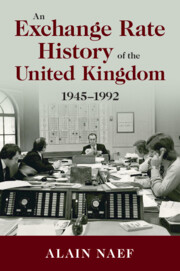The 1992 ERM crisis was the pound’s last currency crisis. Or at least the last one where the Bank managed sterling. The market had won. The Bank no longer dared to fight against speculators, and international finance became too large to control. The Bank switched to inflation targeting and put foreign exchange intervention aside. There were some minor episodes of interventions, notably in 2011 to support the yen. An earthquake and tsunami in Japan had pushed the yen down and the G7 conducted a concerted intervention. Apart from this, intervention had lost its place in the normal arsenal of the Bank.
Strictly speaking, 1992 was not sterling’s last currency crisis. Brexit and the ensuing uncertainty triggered a series of crises. The long process from the referendum, to triggering Article 50, to finally leaving the EU all came with its fair share of shocks to the currency. But the difference with the episodes studied in this book is that the Bank was a bystander. The pound was now facing its troubles wholly unassisted by Bank of England dealers.
The end of the intervention era meant less stress for policymakers at the Bank. There were no more late-night calls to decide how much to spend to defend sterling in Tokyo or New York. Free float meant less embarrassment for Bank officials and policymakers. They no longer had to publicly admit defeat after an unexpected devaluation. By focusing only on inflation, the Bank became more independent. It could now set its own policy, focusing on inflation and not exchange rate management, which still today is the prerogative of the government.
But is intervention still a relevant policy tool today? The academic literature since the 1990s has progressively moved in that direction.Footnote 1 Some of foreign exchange intervention’s most virulent critics have toned down their views. Even the IMF, once opposed to foreign exchange intervention, has taken a more conciliatory view in its revised policy framework.Footnote 2 Intervention, the IMF argues, should not be used to generate competitive advantages. But it could be used to help steer monetary policy. This change was in part a reaction to the 2008 Financial Crisis, when traditional monetary policy lost some edge.
Foreign exchange intervention is now a legitimate policy tool. Britain’s experience over half a century offers some policy lessons. First, intervention usually does not work when it is not aligned with economic fundamentals. That is, intervention alone is rarely going to protect a country from what international finance thinks of its economy. Interest rates are usually a much more powerful tool to adjust international capital flows. They show real commitment to a policy while intervention alone does not.
Another lesson is that secrecy might not be the best solution. Transparency with market actors helps better guide exchange rates. Intervening on currency markets without communicating about it might be inefficient. The 1976 IMF crisis of the pound is a case in point. The Bank of England tried to secretly devalue sterling. Market actors did not understand what the Bank of England was trying to communicate, triggering a currency crisis.
Finally, cooperation among central banks can be powerful enough to move markets, but there are limits. The Gold Pool is a good example. Most major Western central banks joining forces to support the gold price provided stability to the international monetary system. But even the best forms of international technical cooperation can be stopped by political will. This was the case for the election of Nixon, which broke down central bank cooperation with the Fed.

